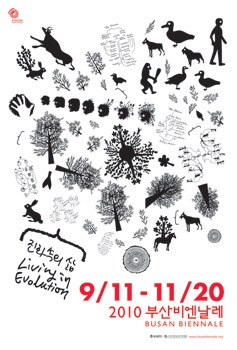The previous Busan biennales had three disparate exhibitions with respective exhibition directors, that is, the Contemporary Art Exhibition, the Sea Art Festival and the Busan Sculpture Project. Departing from the tradition, the 2010 Busan Biennale has one director planning for all exhibitions. By taking this approach, organic cohesion between works and exhibition venues can be achieved and planning directions and messages can be delivered more effectively. Access to the public will be expanded not just through shorter distances between exhibition venues but also through the aim of ensuring organic cohesion between art works and exhibition venues.
The 2010 Busan Biennale is composed of exhibitions and different programs aimed at connecting viewers with exhibitions. This year’s biennale seeks to simplify exhibition content and focus more on the exhibition theme. Combining the Contemporary Art Exhibition, the Sea Art Festival and the Busan Sculpture Project into a single exhibition will help secure consistency in exhibition planning. Furthermore, interlinking exhibition venues and factors affecting exhibitions like the spokes of a wheel will strengthen interconnectedness.
Theme of the main exhibition: “Living in Evolution”
One’s life begins from the moment that he / she is born, and ends at the moment of death. On the other hand, the human race is living on a longer time span which has continued from ancient times. Throughout this long history, the human race has been experiencing the evolution of both intelligence and biological aspects. And it will keep evolving like this in the future. In other words, we are living on a longer evolutionary time axis as well as living individual lives.
However, this is a complex and sometimes contradictory territory. Often the development of economic systems or political power may be the cause of pressures for individual lives, and the developments of science have been used for war. Whilst the inventions of civilization have greatly benefited our daily lives, many people have also criticized these inventions ever since the Industrial Revolution. In the realm of the mass media and advertising the image of beautiful or strong people has become the standard encouraging humans to evolve in this idealized direction. However, such developments have also marginalized many people who do not fit the ideal.
Art, in all its various forms, has contributed to the human race’s intellectual evolution. In the realm of art history, for example, the paintings of Edouard Manet in the 19th century or the objects produced by Marcel Duchamp in the early 20th century, serve as examples of works which were not highly valued at the time of their creation. The value and perception of their works have changed over the passage of time.
We can suggest that the axes of individual life and evolution are not always separate. Sometimes they touch one another, as for instance when an individual artist’s work contributes to the broader human evolution.
We are living individual lives. Yet at the same time, we are living in the processes of evolution. Evolution will continue. But no one knows the direction of this evolution.
The exhibition will try to think through the relations between art, society, world, history and the future by considering the dual time axes in which we are living today.
Main Exhibition
Artistic Director: AZUMAYA, Takashi (Japan. Independent curator)
Theme: ‘Living in Evolution’
Period: Sep. 11- Nov. 20, 2010
(Installations on Gwangalli Beach : Sep. 11 – Oct. 1, 2010)
Artworks: 161 Artworks of 72 artists from 23 countries


